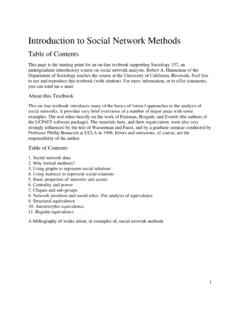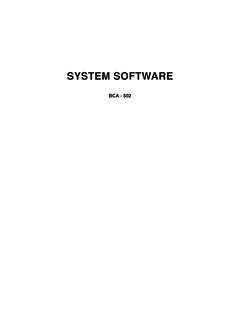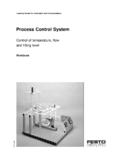Transcription of File, Data, Transform, Tools, Network, Visualize, Options ...
1 UCINET Quick Start Guide This guide provides a quick introduction to UCINET. It assumes that the software has been installed with the data in the folder C:\Program Files\Analytic Technologies\Ucinet 6\DataFiles and this has been left as the default directory. When UCINET is started the following window appears. The submenu buttons give access to all of the routines in UCINET and these are grouped into File, data , transform , Tools, network , visualize , Options and Help. Note that the buttons located below these are simply fast ways of calling routines in the submenus. The default directory given at the bottom is where UCINET picks up any data and stores any files (unless otherwise specified) this directory can be changed by clicking on the button to the right.
2 Running a routine To run a UCINET routine we usually need to specify a UCINET dataset and give some parameters. Where possible UCINET selects some default parameters which the user can change if required. Note that UCINET comes with a number of standard datasets and these will be located in the default directory. When a routine has been run there is some textual output which appears on the screen and usually a UCINET datafile contain the results that again will be stored in the default directory. We shall run the degree centrality routine to calculate the centralities of all the actors in a standard UCINET dataset called TARO.
3 First we highlight network >Centrality>Degree and then click Submenu buttons Exit button Spreadsheet editor DL editor Text editor (notepad) Run Netdraw Current default directory Change default directory button Display dataset Matrix Algebra This will bring up a box as follows If you click on the help button then a help screen will open which looks like this. The help file gives a detailed description of the routine, explains the parameters and describes the output that will appear in the log file and on the screen. Click to run the routine Click to cancel Click to access help associated with this routine Defaults parameters can be changed by selecting from a list Click to open a pick file box Name of UCINET datafile created by this routine.
4 Can be changed by typing over Close the help file and either by clicking on the pickfile button or by typing the name select the TARO data for analysis as follows. Now click OK to run the routine to obtain the following. This is a text file giving the results of the routine. Note you can scroll down to see more of the file. This file can be saved or copied and pasted into a word processing package. When UCINET is closed this file will be deleted. Close this file. Note when the program was run we also created a new UCINET file called FreemanDegree. We can look at the new UCINET file using the Display dataset button.
5 This is the D button that appears just below the Tools submenu (see the first diagram). Clicking on the D goes straight to the open file menu and bypasses some of the display Options that are available if you used data >Display. Click on display and select FreemanDegree. You should get the following Note that this file has all the measures of centrality (but not sorted as in the text output) but does not have the descriptive statistics produced in the log file. Using the spreadsheet editor The spreadsheet editor can be used to amend any data or enter new data . It is also very useful for transferring UCINET data (such as centrality scores) to Microsoft Excel or SPSS.
6 Note that the dl format provides a more sophisticated and flexible way of entering data and this is not covered in this introductory guide. If you click the spreadsheet button or under data run the data editors and click on matrix editor you will open up the spreadsheet editor and obtain the following. Note we have annotated the important buttons and areas of the editor below. To see what a dataset looks like in the editor click file then open and select PADGETT. This is a non-symmetric binary data set with two relations and labels. Once open it will look like this. Area for labels Click File and New to start a new sheet Click edit and insert sheet to add a new relation Click Fill to add zeros into empty cells Click to Import or copy labels Symmetric mode copies cell values into other half Set the network or matrix size here Area for data , numerical values only We see the two relations PADGM and PADGB in the bottom left, clicking on the tabs changes sheet and we are viewing different relations.
7 The labels are repeated along the rows and columns and are in the shaded area. We see the data has 16 actors as shown by the dimensions box on the right. This data can be edited and saved from the spreadsheet. Running Netdraw Click on the Netdraw button to launch Netdraw. This results in a new window which looks like this. We have annotated the most important buttons. To use Netdraw it is important to load in a network first. We shall load in a standard UCINET dataset collected by Dave Krackhardt. Click on the load a file button and type or select the file Krack-High-Tec Clear window Load a file Arrange nodes Remove isolates Show only main component Restore nodes Change label size Colour nodes Change shape of nodes Hide or reveal labels Hide or reveal arrows Change node size Hide or reveal edge weights Then click OK and you should see something like this.
8 Click on the Rels tab indicated here. You will now see this data has three relations Advice, Friendship and Reports to. If a relation is ticked then the edges relating to it are displayed. We shall now bring in an attribute file associated with this data called High-Tec-Attributes. Click on the load a file button again load the file but also click the radio button for node attributes under Type of data so you have Note you can also click the button just to the right of the load button (with an A) and this will open up the same box but with the attribute button selected. Click OK and you will see the node attribute editor open up as follows.
9 We are going to size the nodes by age, colour them by department and shape them according to level. Close the attribute editor and click on the colour node button. This will open the color box click the select attribute button and select department as follows This will give 5 colours for the five departments. Now click on the change shape of nodes button and go through the same process but selecting level and clicking on the tick at the bottom of the box. This will produce three shapes. To size the nodes according to age you need to select Properties>Nodes>Symbols>Size>Attribute- Based and then select Age leaving the other values as defaults.
10 This should result in the following. To export the diagram for use in a publication or to read into a word processing package use File>Save Diagram As>Metafile. To save the diagram as a file you can see again in Netdraw you need to use File>Save data As>Vna. There are many features of UCINET and Netdraw that we have not mentioned but hopefully this guide will get you started.








